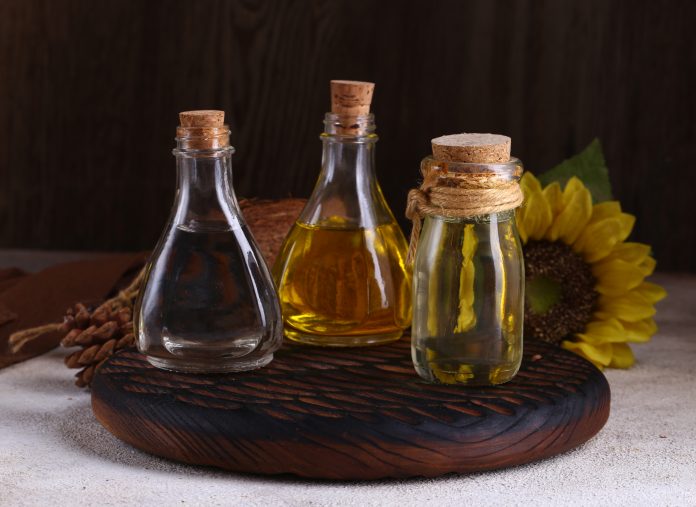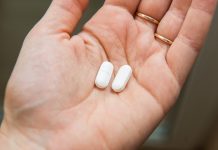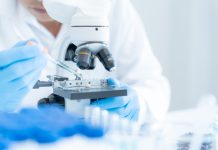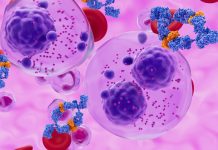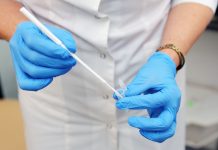Dr Christian Löfke, responsible for research and product development at BioBloom, walks us through the rudiments of essential oils as a potential modulator of the endocannabinoid system
Essential oils (EOs) are natural compositions of volatile aromatic compounds typically distilled or extracted from various plant sources like leaves, flowers, seeds, bark, or resins. These aromatic compounds have a long history as traditional medicine and are nowadays the focus of research for treating a multitude of diseases and promoting health benefits (1). EOs can be absorbed through inhalation (olfactory system), topically through the skin or via oral administration. Interestingly, olfactory receptors are not only expressed in the nasal cavity, but additionally in other essential organs and can, therefore, influence our whole body (2). The main element of EOs are terpenes, which can cross the blood-brain barrier due to their lipophilic nature which makes them potential targets for therapeutic drug development.
The endocannabinoid system (ECS) is an orchestra of enzymes (production and degradation of cannabinoids), cannabinoid receptors (CB1R and CB2R) and molecules that are involved in the regulation of human health and physiology. Both receptors CB1R and CB2R are widely distributed in numerous organs and tissues within the body and have significant signaling and regulatory functions. As a whole, the ECS can be seen as a universal regulator of body functions (3).
Since the legislative restrictions of cannabis-based medicines were loosened, the growing interest in substances regulating the ECS has accelerated. Curiously, cannabinoids are not the only molecules that can modulate the ECS, but essential oils can also directly interfere with ECS machinery.
Beta-Caryophyllene (BC), found amongst other things in hemp (Cannabis sativa), black pepper (Piper nigrum) and copaiba (Copaifera ssp.), with the highest content over 85%, can directly bind exclusively to the CB2R receptor (4) without the psychotropic effect which mediates the CB1R receptor. BC is a promising drug for chronic pain management for both inflammatory and neurogenic pain without the body developing a tolerance unlike classical pain remediation drugs (5). BC could, therefore, be classified as a functional dietary cannabinoid-like substance that activates numerous receptors and downstream responses within the human body (6).
Lavandula angustifolia (lavender) produces an EO primarily composed of linalool and linalyl acetate and is used in aromatherapy for anxiety and stress relief, as well as pain and sleep management (7). A study has demonstrated that lavender EO inhibits the cannabinoid degrading enzyme, fatty acid amide hydrolase (FAAH) which positively influences the central nervous system (ECS) and pain disorders by conserving endocannabinoids and thereby amplifying the ECS signaling (8).

Pinus roxburghii (chir pine) distillates have a variety of different compositions, partly with high BC levels. The EO is rich in sesquiterpene longifolene and activates the CB2R receptor, even in EOs without the terpene BC (9). In an animal model, it could be demonstrated that Chir Pine EO has anti-inflammatory properties and improves the oxidative homeostasis (10).
Cedrus atlantica (atlas cedarwood) EO is used in aromatherapy for treating anxiety and stress-related disorders. It is mainly composed of the sesquiterpenes himachalenes and can activate both the CB1R and CB2R receptor in mice (11) and inhalation shows anti-hyperalgesic properties.
More interestingly, plant-based drugs are complex and unique in their composition with elements of minor molecules changing the effect of the main active ingredients. Some refer to the “entourage effect” related to cannabinoids (12). The linalool present in lavender has a much weaker effect on the mood status when applied in an isolated form as compared to a complex mixture in an EO with the entire minor elements (13). This shows the unique power of natural compositions in EOs and further stresses the complexity of plant-derived drugs.
Dysfunction of the ECS results in a plethora of health-related issues. Essential oils represent promising plant-based medicines for the treatment of health complaints related to an unbalanced ECS and could, for instance, boost the effectiveness of cannabinoid composed preparations. However, to date, no clinical trials have been conducted on EOs and ECS modulation, but the growing body of evidence suggests that in addition to cannabinoids other components derived from EOs can modulate the ECS machinery.
Certified and quality-tested CBD full extracts
The 100% organic and natural CBD oils from BioBloom are available in natural CBD/CBDA concentrations of 1%, 4%, 6% and 8% and 10%.
Many physicians and pharmacists in Austria and Europe already rely on the pure natural hemp oils from BioBloom and use them in the treatment of their patients. The BioBloom certified organic hemp oils are available in pharmacies and selected shops in many European countries. In a comparison test of 46 European CBD products by the independent patient association ARGE CANNA, the BioBloom products were among the test winners and in recognition of their quality, the patient association also awarded them the AC seal of quality.
Innovative product development
The product range at BioBloom also includes the unique hemp flower tea with hemp flowers from the BioBloom fields picked and processed exclusively by hand. Besides, the BioBloom brand also includes hemp food products such as organic hemp oil from peeled hemp seeds and hemp seeds, peeled and ready to eat and the certified organic hemp cosmetic series “Into the Wild”. The cosmetic products are certified organic, vegan, cruelty and palm oil-free, allergen-free and GMP certified.
Four BioBloom types of nutrition (sleeping capsules, magnesium- and Vitamin B complex and Vitamin D drops) are the latest addition to the product range from BioBloom. These kinds of nutrition are 100% plant-based, vegan, lactose-, gluten- and fructose- and GMP-free. The products were developed following the company philosophy focusing on improving people’s health and well-being, as well as the careful handling of nature’s valuable resources.
References
(1) B. Ali, N. A. Al-Wabel, S. Shams, A. Ahmad, S. A. Khan, and F. Anwar, “Essential oils used in aromatherapy: a systemic review,” Asian Pacific Journal of Tropical Biomedicine, vol. 5, no. 8, pp. 601-611, 2015. View at: Publisher Site (https://doi.org/10.1016/j.apjtb.2015.05.007) | Google Scholar (https://scholar.google.com/scholar_lookup?title=Essential%20oils%20used%20in%20aromatherapy:%20a%20systemic%20review&author=B.%20Ali&author=N.%20A.%20Al-Wabel&author=S.%20Shams&author=A.%20Ahmad&author=S.%20A.%20Khan&author=&author=F.%20Anwar&publication_year=2015)
(2) D. MaBerg and H. Hatt, “Human olfactory receptors: novel cellular functions outside of the nose,” Physiological Reviews, vol. 98, no. 3, pp. 1739-1763, 2018.View at: Publisher Site (https://journals.physiology.org/doi/full/10.1152/physrev.00013.2017?url_ver=Z39.88-2003&rfr_id=ori%3Arid%3Acrossref.org&rfr_dat=cr_pub++0pubmed&) | Google Scholar (https://scholar.google.com/scholar_lookup?title=Human%20olfactory%20receptors:%20novel%20cellular%20functions%20outside%20of%20the%20nose&author=D.%20MaBerg%20&author=H.%20Hatt&publication_year=2018)
(3) C. A. Sallaberry and L. Astern, “The endocannabinoid system, our universal regulator,” Journal of Young Investigators, vol. 34, no. 6, pp. 48-55, 2018.View at: Publisher Site (https://www.jyi.org/2018-june/2018/6/1/the-endocannabinoid-system-our-universal-regulator) | Google Scholar (https://scholar.google.com/scholar_lookup?title=The%20endocannabinoid%20system,%20our%20universal%20regulator&author=C.%20A.%20Sallaberry%20&author=L.%20Astern&publication_year=2018)
(4) T. Alberti, W. Barbosa, J. Vieira, N. Raposo, and D. Rafael, “(−)-β-caryophyllene, a CB2 receptor-selective phytocannabinoid, suppresses motor paralysis and neuroinflammation in a Murine model of multiple sclerosis,” International Journal of Molecular Sciences, vol. 18, no. 4, p. 691, 2017.View at: Publisher Site (https://www.mdpi.com/1422-0067/18/4/691) | Google Scholar (https://scholar.google.com/scholar_lookup?title=(%E2%88%92)-%CE%B2-caryophyllene,%20a%20CB2%20receptor-selective%20phytocannabinoid,%20suppresses%20motor%20paralysis%20and%20neuroinflammation%20in%20a%20Murine%20model%20of%20multiple%20sclerosis&author=T.%20Alberti&author=W.%20Barbosa&author=J.%20Vieira&author=N.%20Raposo&author=&author=D.%20Rafael&publication_year=2017)
(5) A.-L. Klauke, I. Racz, B. Pradier et al., “The cannabinoid CB2 receptor-selective phytocannabinoid beta-caryophyllene exerts analgesic effects in mouse models of inflammatory and neuropathic pain,” European Neuropsychopharmacology, vol. 24, no. 4, pp. 608-620, 2014.View at: Publisher Site (https://www.sciencedirect.com/science/article/pii/S0924977X13003027?via%3Dihub) | Google Scholar (https://scholar.google.com/scholar_lookup?title=The%20cannabinoid%20CB2%20receptor-selective%20phytocannabinoid%20beta-caryophyllene%20exerts%20analgesic%20effects%20in%20mouse%20models%20of%20inflammatory%20and%20neuropathic%20pain&author=A.-L.%20Klauke&author=I.%20Racz&author=B.%20Pradier%20et%20al.&publication_year=2014)
(6) C. Sharma, J. M. Al Kaabi, S. M. Nurulain, S. N. Goyal, M. A. Kamal, and S. Ojha, “Polypharmacological properties and therapeutic potential of β-caryophyllene: a dietary phytocannabinoid of pharmaceutical promise,” Current Pharmaceutical Design, vol. 22, no. 21, pp. 3237-3264, 2016.View at: Publisher Site (http://www.eurekaselect.com/140352/article) | Google Scholar (https://scholar.google.com/scholar_lookup?title=Polypharmacological%20properties%20and%20therapeutic%20potential%20of%20%CE%B2-caryophyllene:%20a%20dietary%20phytocannabinoid%20of%20pharmaceutical%20promise&author=C.%20Sharma&author=J.%20M.%20Al%20Kaabi&author=S.%20M.%20Nurulain&author=S.%20N.%20Goyal&author=M.%20A.%20Kamal&author=&author=S.%20Ojha&publication_year=2016)
(7) P. H. Dunn, M. K. Ghadiri, and A. Gorji, “Lavender and the nervous system,” Evidence Based Complementary and Alternative Medicine, vol. 2013, Article ID 681304, 10 pages, 2013.View at: Publisher Site (https://www.hindawi.com/journals/ecam/2013/681304/)| Google Scholar (https://scholar.google.com/scholar_lookup?title=Lavender%20and%20the%20nervous%20system&author=P.%20H.%20Dunn&author=M.%20K.%20Ghadiri&author=&author=A.%20Gorji&publication_year=2013)
(8) K. Ahn, D. S. Johnson, and B. F. Cravatt, “Fatty acid amide hydrolase as a potential therapeutic target for the treatment of pain and CNS disorders,” Expert Opinion on Drug Discovery, vol. 4, no. 7, pp. 763-784, 2009.View at: Publisher Site (https://www.tandfonline.com/doi/full/10.1517/17460440903018857) | Google Scholar (https://scholar.google.com/scholar_lookup?title=Fatty%20acid%20amide%20hydrolase%20as%20a%20potential%20therapeutic%20target%20for%20the%20treatment%20of%20pain%20and%20CNS%20disorders&author=K.%20Ahn&author=D.%20S.%20Johnson&author=&author=B.%20F.%20Cravatt&publication_year=2009)
(9) R. Labib, F. Youssef, M. Ashour, M. Abdel-Daim, and S. Ross, “Chemical composition of pinus roxburghii bark volatile oil and validation of its anti-inflammatory activity using molecular modelling and bleomycin-induced inflammation in albino mice,” Molecules, vol. 22, no. 9, p. 1384, 2017.View at: Publisher Site (https://www.mdpi.com/1420-3049/22/9/1384) | Google Scholar (https://scholar.google.com/scholar_lookup?title=Chemical%20composition%20of%20pinus%20roxburghii%20bark%20volatile%20oil%20and%20validation%20of%20its%20anti-inflammatory%20activity%20using%20molecular%20modelling%20and%20bleomycininduced%20inflammation%20in%20albino%20mice&author=R.%20Labib&author=F.%20Youssef&author=M.%20Ashour&author=M.%20Abdel-Daim&author=&author=S.%20Ross&publication_year=2017)
(10) C. McEwen and H. S. Hundal, “Modulation of cellular redox homeostasis by the endocannabinoid system,” Open Biology, vol. 6, no. 4, Article ID 150276, 2016.View at: Publisher Site (https://doi.org/10.1098/rsob.150276) | Google Scholar (https://scholar.google.com/scholar_lookup?title=Modulation%20of%20cellular%20redox%20homeostasis%20by%20the%20endocannabinoid%20system&author=C.%20McEwen%20&author=H.%20S.%20Hundal&publication_year=2016)
(11) A. A. Emer, N. N. Donatello, A. P. Batisti, L. A. Oliveira Belmonte, R. S. Adair, and D. F. Martins, “The role of the endocannabinoid system in the antihyperalgesic effect of Cedrus atlantica essential oil inhalation in a mouse model of postoperative pain,” Journal of Ethnopharmacology, vol. 210, pp. 477-484, 2018. View at: Publisher Site (https://www.sciencedirect.com/science/article/pii/S0378874117320172?via%3Dihub) | Google Scholar (https://scholar.google.com/scholar_lookup?title=The%20role%20of%20the%20endocannabinoid%20system%20in%20the%20antihyperalgesic%20effect%20of%20Cedrus%20atlantica%20essential%20oil%20inhalation%20in%20a%20mouse%20model%20of%20postoperative%20pain&author=A.%20A.%20Emer&author=N.%20N.%20Donatello&author=A.%20P.%20Batisti&author=L.%20A.%20Oliveira%20Belmonte&author=R.%20S.%20Adair&author=&author=D.%20F.%20Martins&publication_year=2018)
(12) E. B. Russo,” Taming THC: potential cannabis synergy and phytocannabinoid-terpenoid entourage effects, Br J Pharmacol. 2011 Aug; 163(7): 1344-1364.
(13) É. R. Q. dos Santos, C. S. F. Maia, E. A. Fontes Junior, A. S. Melo, B. G. Pinheiro, and J. G. S. Maia, “Linalool-rich essential oils from the Amazon display antidepressant-type effect in rodents,” Journal of Ethnopharmacology, vol. 212, pp. 43-49, 2018.View at: Publisher Site (https://www.sciencedirect.com/science/article/abs/pii/S0378874117322444?via%3Dihub) | Google Scholar (https://scholar.google.com/scholar_lookup?title=Linalool-rich%20essential%20oils%20from%20the%20Amazon%20display%20antidepressant-type%20effect%20in%20rodents&author=%C3%89.%20R.%20Q.%20dos%20Santos&author=C.%20S.%20F.%20Maia&author=E.%20A.%20Fontes%20Junior&author=A.%20S.%20Melo&author=B.%20G.%20Pinheiro&author=&author=J.%20G.%20S.%20Maia&publication_year=2018)
*Please note: This is a commercial profile

